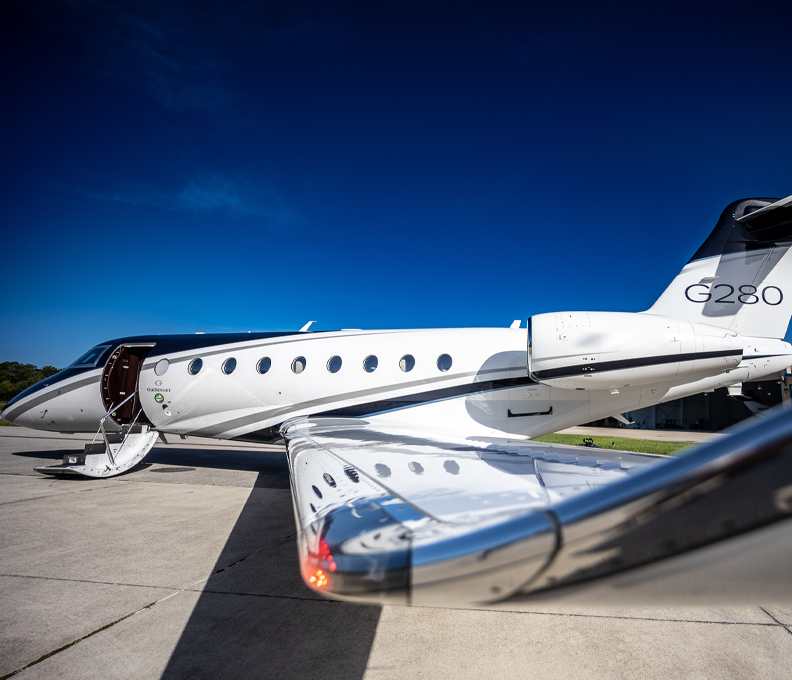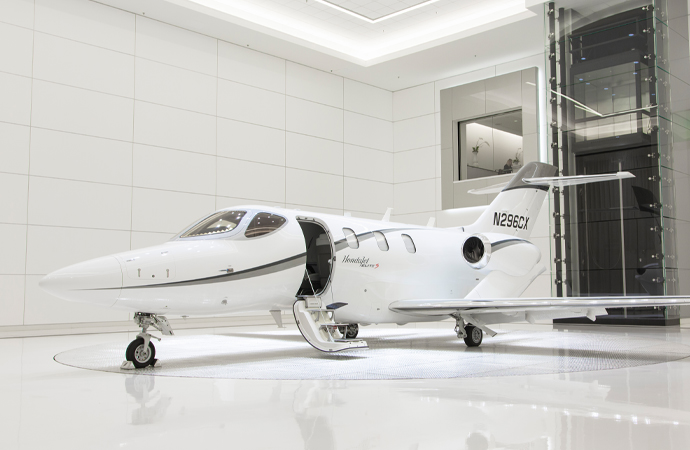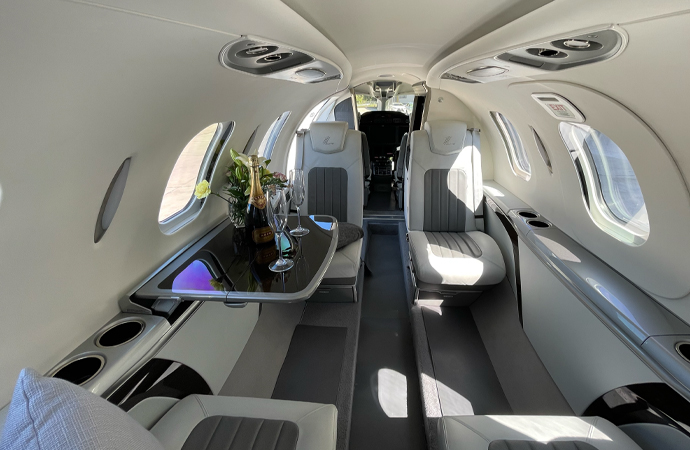Volato: Private Aviation That Highlights the Give-Back
by Lark Gould
April 11, 2023

Gulfstream G280 / Photo: Courtesy of Volato
As private aviation ascends in popularity among those who count time in gold rather than secondhand bites, it’s hard to ignore certain questions about the sustainability of such a precious convenience. Air travel at any level easily emits significantly more CO2 than any other form of shared transport, with the issue of sustainability lurking in the shadows as an inconvenient truth. Volato, one of the newest entrants to the private aviation front, has some thoughts about that … and possible answers for protecting the future of the planet.
Volato launched in August 2021 with a small fleet of HondaJet Elite aircraft: four-passenger luxury planes that, in Volato CEO, Matt Liotta’s estimation, took the gold standard Phenom 300 and spun it on its head when it comes to fuel efficiency and flying distances. And now some 25 all-new HondaJet Elite II business aircraft models are making their way into the fleet. The most environmentally efficient aircraft in the private aviation skies so far, the HondaJets are contributing to Volato’s quest for staying in and above its class when it comes to keeping the planet green.
“It is a very efficient plane in terms of the fuel it uses. In fact, it is correct to say that among twin jets, this plane is the most efficient–these factors are super important from a sustainability standpoint,” says Liotta.

Photo: Courtesy of Volato
Path to Purpose
Liotta plotted his path toward launching Volato during his time as a technical innovator in the agriculture industry over the past decade. In that position he was often flying to remote airports and working with companies and governments to create ways to grow nature’s bounty in otherwise inhospitable terrains. And naturally, he found himself booking private flights and heading to small airports on more or less empty aircraft.
“Often, my business meetings were just me or maybe one other person,” Liotta recalls. “I just couldn’t justify flying a six-passenger jet for one or two people to go to those meetings, even though private aviation was the right answer.
“What we’ve learned in the marketplace is that 70 percent of the private aviation missions are four passengers or less. So we think putting those four passengers on a HondaJet means that we’re able to save enormous amounts of operating costs by using the right equipment,” he adds. “And more than just efficiency, we felt the HondaJet had one of the best cabins in its class. It’s quieter because of the unique engine design. It’s got a better lavatory than others, and it provides that luxurious cabin experience our customers are looking for while delivering on efficiency–both environmentally and financially.”
One good idea lead to another and Liotta soon had funding and partners for a product that covered an oft-ignored gap in the demand: the small group or individual that flies frequently and needs to keep costs down and accessibility up.
Vision with Benefits
Volato currently operates 18 HondaJets toward a total of 40 that will be on the books once deliveries are taken. They are fractionalized aircraft, owned by customers who may enjoy tax benefits, flexible owner usage systems such as the ability to fly as much or as little as they like, and generous revenue shares based on the size of the fraction owned and charter usages. This “democratization” of the aircraft and fleet has caught on fast but the company is staying apace with new planes in the offing with the entrance of four 10-seater Gulfstream G280 super midsized aircraft arriving early next year.
Key in Liotta’s model is the flexibility Volato affords. Because a flyer cannot always predict how much usage will be needed in a given year or period of time, the company offers fractional shares as low as 1/16 with no penalties or restrictions on flight hours and a revenue share whenever the craft is flown for a live mission. They also offer the Volato Stretch Jet Card concept for rewarding passengers when they can be flexible with their departure times, the Volato Insider Membership program with capped hourly rates at $7k, and one-off charter bookings all on their national floating fleet of HondaJets.
The HondaJet Advantage
A firm believer in sustainability practices, Liotta chose HondaJet as the emblem of Volato’s fleet for its impressive numbers. The Elite II brings a maximum range of 1,547 nautical miles (1,780 miles, and 126 miles farther than its Elite S predecessor), according to Honda Aircraft Co. reports, although it is closer to 1,000 miles when fully loaded. As the light jet entered service, it took its place as the fastest, highest, and longest-ranged private aircraft in its class with a maximum speed of 485 miles per hour and a cruising altitude of up to 43,000 feet.

Photo: Courtesy of Volato
The planes are configured with four two-toned leather swiveling lounge seats and stowaway tables for passengers within a spacious 12-foot cabin fitted with a private sky-lit private lavatory. Premium amenities include Bongiovi Aviation’s speakerless audio system, fast satellite-based Wi-Fi, USB ports, even dimmable windows. The cabin is also quiet when compared to other light jets, as engines are mounted over the wings.
A fifth passenger can be accommodated when necessary in a lavatory or galley jumpseat. The roomy cabin affords plenty of legroom and a galley area for snacks and beverages. With engines on the wings, some 66 cubic feet of luggage space is available for, say, nine full-sized suitcases, or four sets of golf clubs.
Airports? The U.S. currently has more than 5,000 public small craft airports and 14,400 private airports. For commercial jetliners, that number shrinks to 500. The Atlanta, GA-based company operates nationally with hubs in Atlanta, St Augustine and Ft Lauderdale FL, Baltimore MD, Houston TX, and Carlsbad CA. where planes can be serviced and also be pumped with new SAF (sustainable aviation fuels) when supplies are available.
Environmental sustainability is a hard climb for any private air company. From biofuels to battery-powered aircraft, there are no easy answers for ways to shrink this telltale carbon footprint. Private jets may account for as much as 14 times the carbon emissions per passenger versus commercial aircraft, although others note that with a reasonable number of travelers, a business flight’s output could be comparable to a single person driving a Ford F-150 pickup. A small private jet can emit two metric tons of CO2 in just an hour. Commercial aircraft in general account for more than two percent of global emissions.

Photo: Courtesy of Volato
Going for the Green
To this end, other measures are required to offset these numbers toward a horizon of carbon neutrality in the private aviation space. Volato works with 4AIR, a company that assists members of the private aviation sector with mitigating carbon footprints to offset 100 percent of the CO2 in their fleet through a variety of verified offset options. These include carbon credits that fund emissions reduction projects, solar energy efficiency projects, and renewable energy projects in developing nations, which have added social benefits.
While no solution is perfect, in a world where time is the consummate commodity, a flight that comes with a contrail of answers addressing environmental concerns, energy development, remote transport needs, usage flexibility and benefits, and even gets its passengers to their meetings on time–the weight is clearly on the plus side for Volato with plenty more “yes!” marks yet to come.




